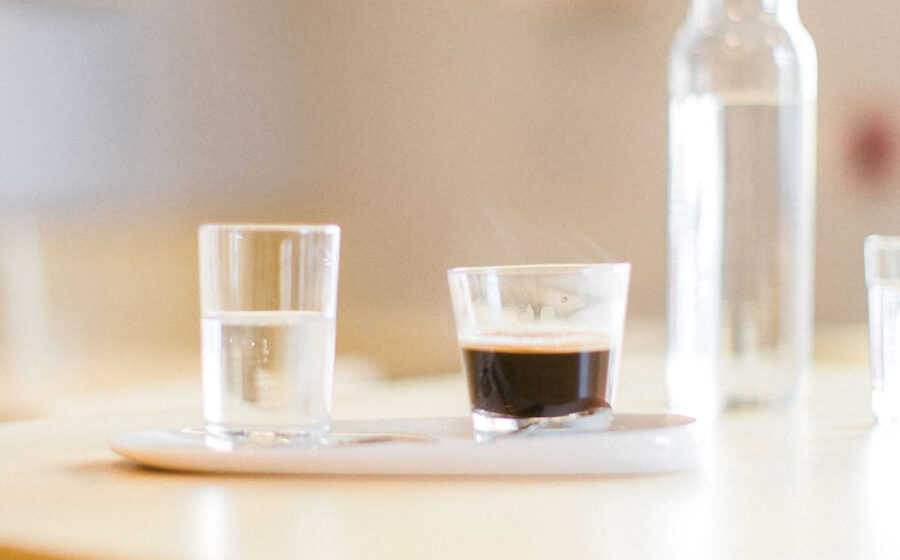[I]f you walk into Nashville’s Steadfast Coffee and order an espresso, it won’t come in a demitasse. It probably wouldn’t fit in one anyway. Instead, you’ll get a rocks glass that’s more than half full. Each of Steadfast’s seasonal, single-origin espressos gets its own recipe, but with a dose of 17.5 grams and yields up to 50 grams, the espresso always has a significantly lower concentration, a lower amount of total dissolved solids, than what many specialty coffee drinkers expect. Just don’t call it weak.
“That lower strength adds to clarity,” says Lee Sill, Steadfast Coffee’s director of wholesale and assistant roaster.
“We compare it to a cask strength whiskey,” says Robbie Melton, Steadfast’s head barkeeper. “A splash of water really opens up the flavors.” (The shot in the photograph at the top of the story is one of theirs. It’s an AB Githinna that was 17.5 grams in and 56 grams out.) For Steadfast, this means serving espresso at a 7 percent concentration, a far cry from the 11–12 percent strength that until recently was the undeniable industry standard.
One factor behind the rise of lower strength espresso is the proliferation of coffee companies using refractometers to set brewing parameters.
Advocates of lower strength espresso are adamant that it only works with a certain roasting style. Lighter roasted coffees are less soluble than traditional, darker espresso roasts and require more water to get the same extraction. Before joining Steadfast, Sill worked at a café that bought coffee from multiple roasters. He discovered that different roasting styles demanded different espresso parameters. “I would pull a ristretto with one roaster, three-to-one with another,” says Sill. “With these lighter coffees I can be more aggressive with the pull and be able to get away with it without negative tastes attributes.”
Steadfast is not the only café with a penchant for lower strength espresso. A recent survey conducted by James Hoffmann, co-owner of Square Mile Coffee Roasters, revealed that in cities around the globe baristas are favoring a 1:2 ratio. (An espresso with twelve percent concentration is usually a 1:1.5 to 1:1.8 ratio.) In Sydney, the average espresso recipe was 20.6:47.2, a 1:2.3 ratio. While few companies are pulling ratios as high as Steadfast, Hoffmann’s data points to espresso getting weaker as a global trend.
One factor behind the rise of lower strength espresso is the proliferation of coffee companies using refractometers to set brewing parameters. By refracting light through a sample, a refractometer can measure the percentage of total dissolved solids (TDS) in the brew. Coupled with the mass of the dose and yield, the TDS can be used to calculate the extraction percentage, that is, what percentage of the ground coffee was dissolved into the beverage. For many roasters and cafés, the new data was eye opening. Some companies found their espresso recipes were extracting far less coffee than they thought. Rather than roasting darker to make the coffee more soluble, some roasters opted to adjust their recipe to increase their extraction. “The thought process is to use more water to get around a twenty percent extraction,” says Melton.
But one early proponent of lower strength espresso is now questioning the trend. “I roasted way too light for years,” says Wille Yli-Luoma, founder of Portland’s Heart Roasters. Heart once served espresso in cappuccino cups due to its large volume, but recently has been pulling their espresso at a more conventional strength of eleven percent. “We hit a maximum point,” says Yli-Luoma. “It was not strong enough. The body was not working together with the flavor.”
Yli-Luoma credits recent adjustments to his roasting technique to being able to get a high-extraction espresso without sacrificing strength. “I want to taste no roast defects. I want to taste terroir, but I don’t want to taste grass,” says Yli-Luoma.
Although Yli-Luoma concedes that lower strength espresso has certain benefits, he argues consumers prefer a more conventional concentration. “On its own it tastes great. There’s lots of flavor clarity,” he says of large shots. “But it gets lost in milk. You have cappuccinos that don’t taste like anything. When the TDS is past 11, you have a better ratio of milk and coffee.” According to Yli-Luoma, Heart’s clientele has already noticed the improvement. “Customers are coming back for second cappuccinos.”
Proponents of lower strength espresso recognize it may not be for everyone, but they continue to push the limits of espresso extraction. “It’s not right or wrong.” says Sill. “At the end of the day, we value clarity and complexity above everything else.”
—Michael Butterworth is a regular contributor to Fresh Cup and the founder of the Coffee Compass.
















